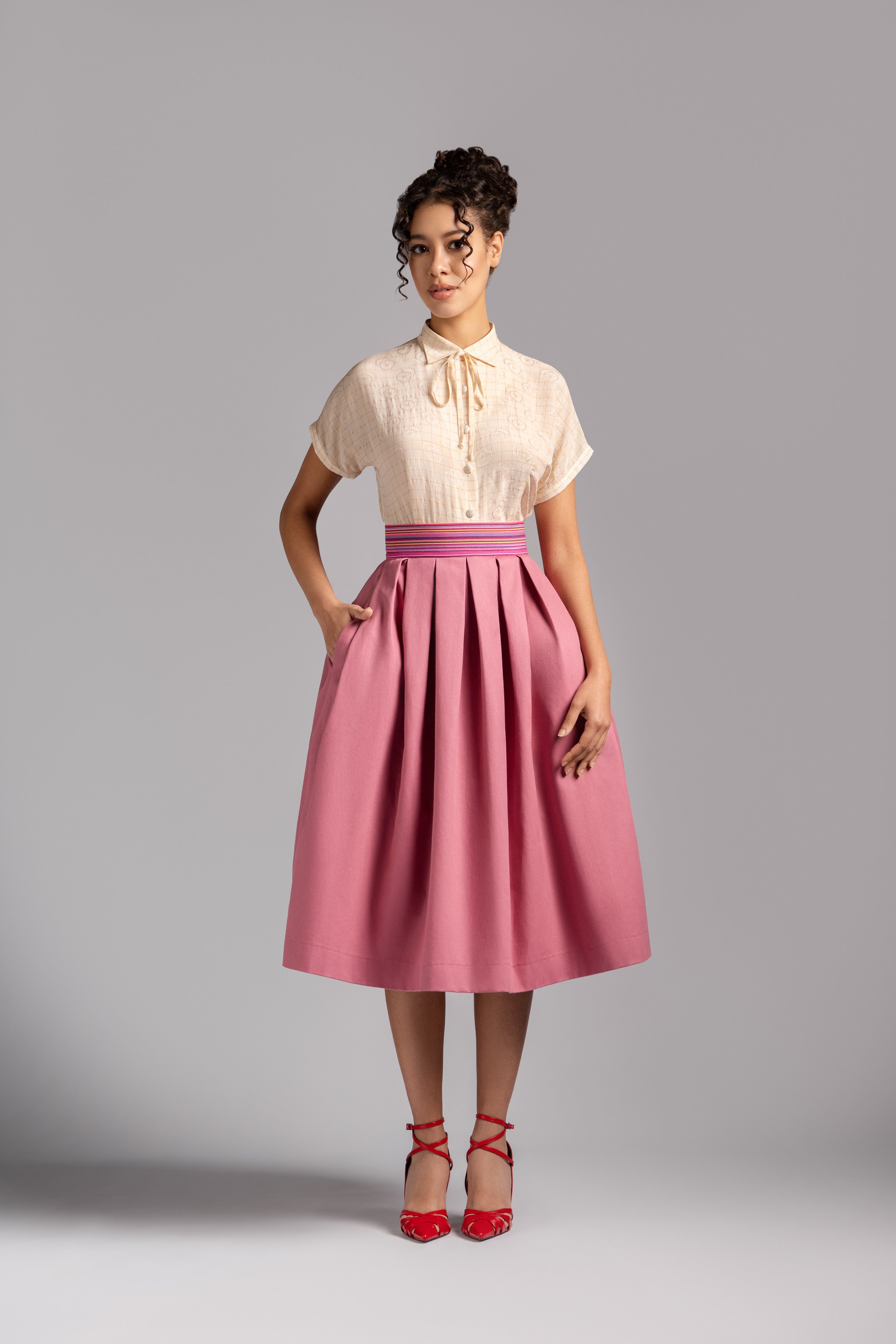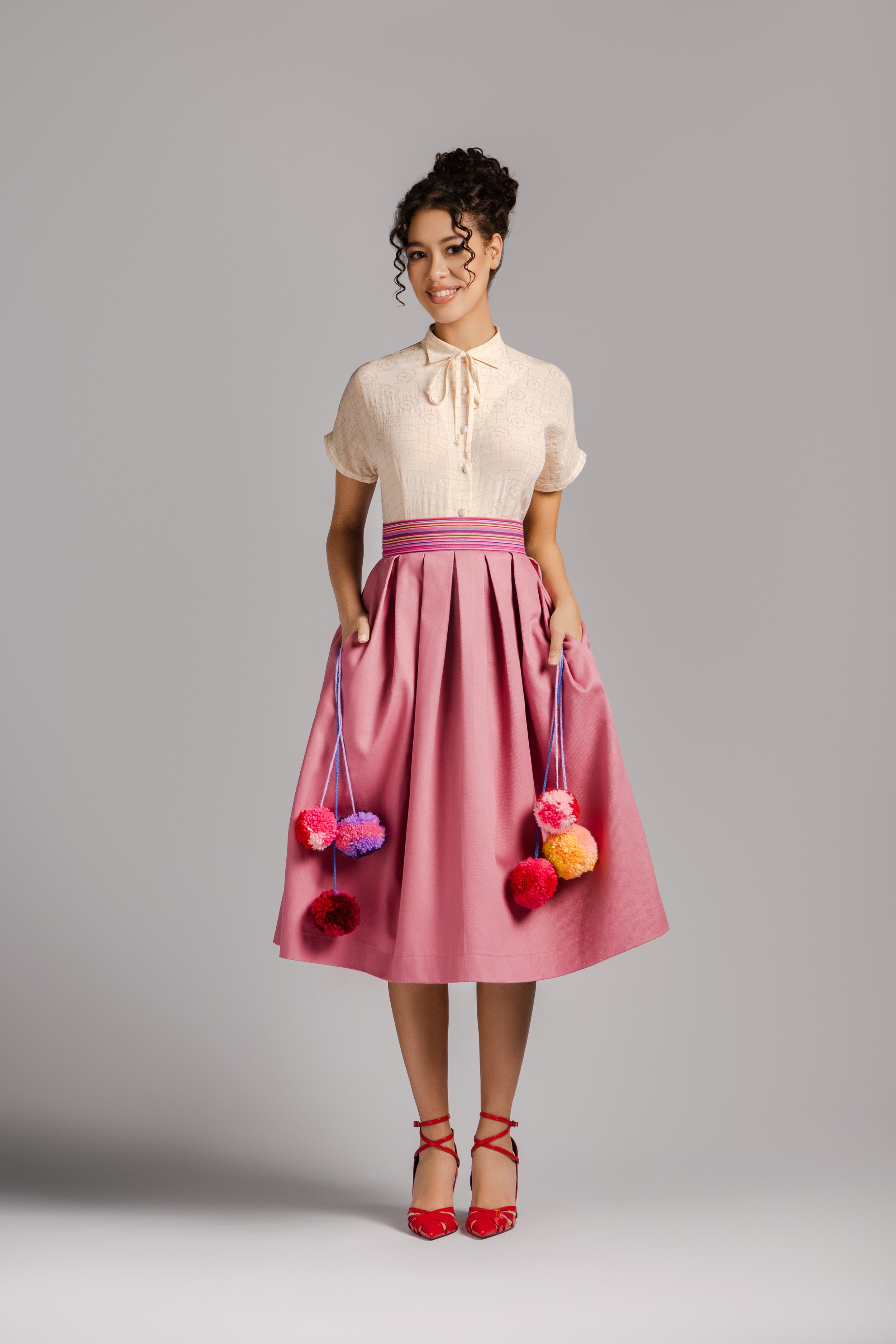

The Stefanny Skirt
This skirt features a classic 1950s cut with flattering box pleats, practical pockets, and a discreet back zipper. The waistline is cinched with a belt decorated in Agyao-inspired fabric. It is a tribute to the journey of Stefanny Sarich, a psychotherapist and social worker, who was forced to leave Bolivia and start a new life in Maryland, USA.
The skirt has a secret that may brighten your day: colorful pompoms inside each pocket, which you can keep hidden, knowing they are there, or proudly show to the world.
About the Design
Stefanny shares the story of domestic violence in her family, which led her to become an undocumented immigrant in Maryland. Her journey of adapting to a new culture while deeply longing for the culture she left behind has been a significant part of her experience.
While working on the design, I wanted to combine several elements:
The traditional colorful aguao fabric. This fabric, traditionally used by women to carry children and goods to market, is often made from llama or alpaca wool and features vibrant stripes and geometric patterns. Steffany shared that when she moved to the USA from Bolivia, the only personal item she brought with her was a diary decorated with aguao fabric.
The shape of the classic 1950s skirt.
The pollera skirt, traditionally worn by rural women in Bolivia, known as Cholitas.
Polleras originated as a form of Spanish colonial dress enforced sometime between the 16th and 17th centuries on indigenous populations in the Andes by hacienda owners or haciendados, particularly when they were baptized. Today, polleras are worn proudly as a symbol of cultural pride.
While researching polleras, I discovered the fighting cholitas—female wrestlers from El Alto, Bolivia. These women are part of a group called the Titans of the Ring, which includes both male and female wrestlers. The fighting cholitas perform in traditional Bolivian dress, including the pollera, manta (a shawl), and a cylinder hat. I was inspired by these fierce women, who challenge traditional gender roles in Bolivian society.
In her story, Stefanny shared how difficult it was for her to adapt to American culture, and her longing for communal life in Bolivia—celebrations, carnivals, and folkloric dances. During a discussion with my friend, British writer Hannah Terrett, she suggested incorporating pompoms into the design. The symbolism is simple yet powerful: you always carry your memories with you, and you're proud to share your culture with others.
This skirt features a classic 1950s cut with flattering box pleats, practical pockets, and a discreet back zipper. The waistline is cinched with a belt decorated in Agyao-inspired fabric. It is a tribute to the journey of Stefanny Sarich, a psychotherapist and social worker, who was forced to leave Bolivia and start a new life in Maryland, USA.
The skirt has a secret that may brighten your day: colorful pompoms inside each pocket, which you can keep hidden, knowing they are there, or proudly show to the world.
About the Design
Stefanny shares the story of domestic violence in her family, which led her to become an undocumented immigrant in Maryland. Her journey of adapting to a new culture while deeply longing for the culture she left behind has been a significant part of her experience.
While working on the design, I wanted to combine several elements:
The traditional colorful aguao fabric. This fabric, traditionally used by women to carry children and goods to market, is often made from llama or alpaca wool and features vibrant stripes and geometric patterns. Steffany shared that when she moved to the USA from Bolivia, the only personal item she brought with her was a diary decorated with aguao fabric.
The shape of the classic 1950s skirt.
The pollera skirt, traditionally worn by rural women in Bolivia, known as Cholitas.
Polleras originated as a form of Spanish colonial dress enforced sometime between the 16th and 17th centuries on indigenous populations in the Andes by hacienda owners or haciendados, particularly when they were baptized. Today, polleras are worn proudly as a symbol of cultural pride.
While researching polleras, I discovered the fighting cholitas—female wrestlers from El Alto, Bolivia. These women are part of a group called the Titans of the Ring, which includes both male and female wrestlers. The fighting cholitas perform in traditional Bolivian dress, including the pollera, manta (a shawl), and a cylinder hat. I was inspired by these fierce women, who challenge traditional gender roles in Bolivian society.
In her story, Stefanny shared how difficult it was for her to adapt to American culture, and her longing for communal life in Bolivia—celebrations, carnivals, and folkloric dances. During a discussion with my friend, British writer Hannah Terrett, she suggested incorporating pompoms into the design. The symbolism is simple yet powerful: you always carry your memories with you, and you're proud to share your culture with others.